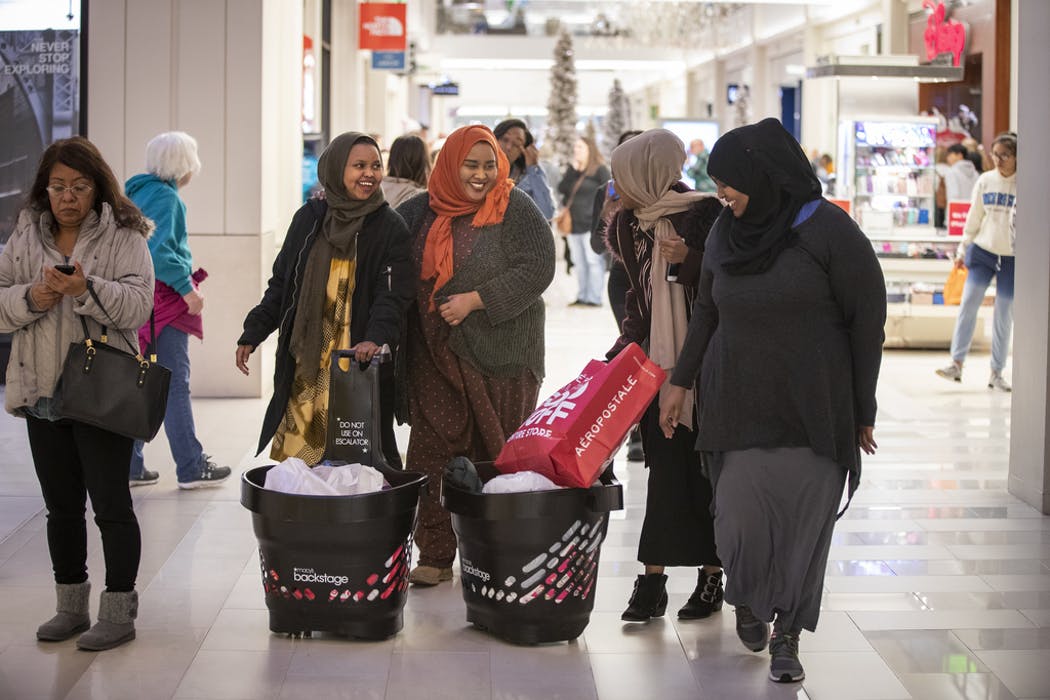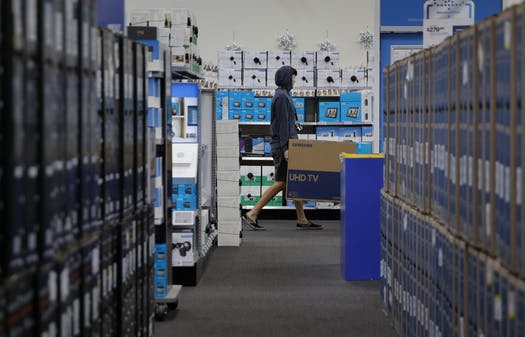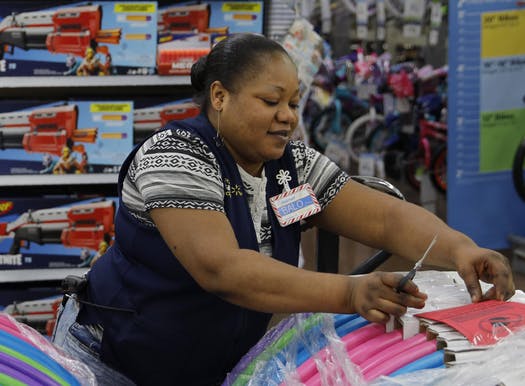| BUSINESS 565523672 Ready, set, shop: Is a record-setting $1 trillion retail holiday season in the offing? Key trends to watch as stores raise the curtain on the busy shopping season By Jackie Crosby Star Tribune NOVEMBER 27, 2019 — 7:31PM |
No longer a one-day dash for doorbusters, retail watchers now count the five days between Thanksgiving and Cyber Monday as the holiday season's curtain raiser.
If Christmas creep and increased traffic in your neighborhood touches off your inner grouch, consider that retail is America's largest private-sector employer, supporting one in four U.S. jobs and adding $2.6 trillion to the annual GDP.
The upcoming holiday season presents a mixed bag for retailers, analysts said. Consumers feel pretty good about their household finances. Wages have inched up and the unemployment rate is hovering near a 50-year low.
As Target Corp. Chief Executive Brian Cornell told reporters last week: "There is no indicator as we sit here today that the consumer environment is slowing as we enter the holiday season."
But an undercurrent of uncertainty exists, with hints of a recession and the lingering overhang of tariffs and a trade war. A late Thanksgiving could put pressure on retail growth, and promotions may cut into profits.
| As the critical holiday season gets underway, here are some defining trends and expectations for the coming months. The outlook The 2019 holiday could mark retailers' first ever trillion-dollar shopping season, according to a number of market-research firms, including Deloitte and eMarketer. |
Twin Cities shoppers, who typically fall below the national average, are expected to spend $649, according to Accenture.
Consumer-buying patterns can flicker. Last year's holiday sales came in below forecasts, growing by 2.1% to $686 billion, as a government shutdown, rising trade tensions and a late-December stock market plunge merged into a trifecta that spooked consumers.
Yet even with double-digit growth in e-commerce and shifting attitudes to seek out experiences over stuff, most researchers said the extended Black Friday weekend has not lost its luster.
"There's always going to be an appetite for consumers to think about their shopping plans, whether they're doing it in their pajamas or doing that at 4 a.m. in front of a brick-and-mortar retailer," said Michael Sansone, a Minneapolis-based leader in the consumer and retail practice of global consultant A.T. Kearney. "Regardless, they're going to be in a shopping spirit."
The calendar crunch
A turn of the calendar leaves six fewer shopping days between Thanksgiving and Christmas this year. The compressed time frame could weigh on retailers' profit potential as it robs them of that extra weekend of potential sales. But consumers could see more deals as retailers compete for dollars.
More than half of retailers surveyed by RetailMeNot and Kelton said they plan to offer deeper discounts than usual. Most began running deals earlier this year.
Walmart started its holiday sales Oct. 25. Kohl's conducted a "holiday kickoff" on Nov. 1.
It might be working. Between Nov. 15 and 21, Nordstrom Inc. saw web revenue almost double while Walmart's grew 67% in a recent survey of U.S. retailers by Edison Trends.
"It's likely to be very competitive out there in terms of pricing," said Retail Metrics analyst Ken Perkins. "There should be some good deals for consumers."
Bricks and clicks
Brick-and-mortar stores remain the dominant sales channel, accounting for nearly 87% of total holiday spending. But e-commerce will be nearly as significant. Two-thirds of holiday shoppers are likely to buy gifts both online and in stores this year, according to Deborah Weinswig, CEO of Coresight Research.
| "Consumers desire frictionless shopping experiences," she said in a recent report. Holiday e-commerce sales will rise more than 13% this year, more than three times faster than the total retail growth rate, eMarketer predicts. 'Free' shipping The real battlefront is delivery. Free shipping trumps fast shipping by more than 5-1, Deloitte researchers found. In fact, shoppers are willing to wait up to seven days to get an item if they don't feel they are paying the cost of freight. |
"This is the time when Amazon starts to take share from everybody," Retail Metrics' Perkins said.
Richfield-based Best Buy kicked off the holidays with an Oct. 22 announcement that it, too, would offer free next-day delivery, putting it in the shipping game with Target, Walmart and Amazon. Target Corp. is sinking an additional $50 million in payroll this year, doubling its staff dedicated to filling digital orders, including same-day services.
Amazon continues to sacrifice short-term profits in a bid for long-term customer loyalty. In the third quarter, shipping costs rose 46%, or $3 billion compared with last year.
"Amazon can absorb this margin erosion far better than most of its rivals," said Neil Saunders, an analyst with GlobalData Retail. "This is because of the profitability of its other service divisions and because of the tolerance of investors. So, in a sense, Amazon is still winning the long-term war of attrition."
No last-minute rush?
Once upon a time, malls could count on a flurry of last-minute shoppers. But the convenience of online shopping has led to a plunge in procrastination.
The growing popularity of Amazon's Prime Day event in summer is part of shifting shopping patterns. A third of consumers surveyed by market research firm NPD Group said they did some holiday shopping during the two-day Prime event in July.
In 2011, last-minute Larrys and Lolas accounted for more than a third of shoppers. This year, fewer than 20% planned to start late.
It's the "new normal" of the holiday shopping season, the NPD report asserted.
Jackie Crosby is a general assignment business reporter who also writes about workplace issues and aging. She has also covered health care, city government and sports.
[email protected] 612-673-7335 jackiecrosby





 RSS Feed
RSS Feed